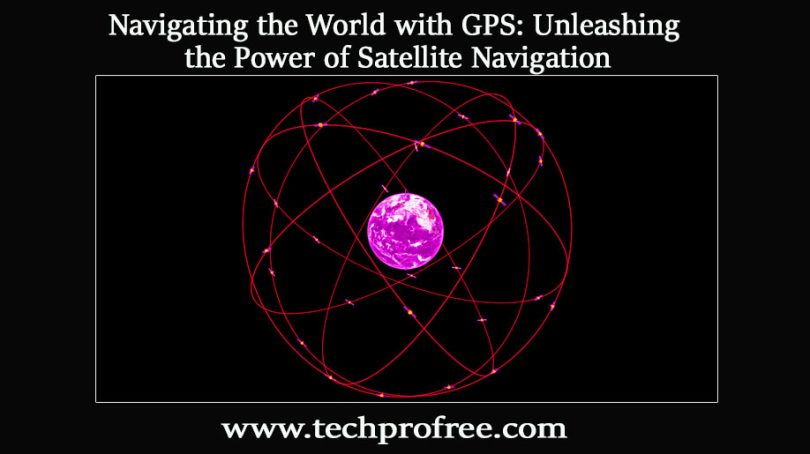Exploring GPS: A Worldwide Satellite Navigation System:
The Global Positioning System (GPS) is an internationally implemented satellite navigation system that offers accurate data on positioning, velocity, and time synchronization. It offers these essential capabilities on a worldwide scale. It is widely utilized in various devices such as cars, smartphones, watches and other smart gadgets to assist users in reaching their destinations.
For a comprehensive understanding of GPS and its operational mechanisms, please read and refer to this article.
Decoding the GPS: Functioning Principle:
GPS coordinates information about location, speed, and time for transit across multiple environments, including air, water and the ground, using satellites, a device that receives the data, and algorithms.
GPS comprises 24 satellites arranged in six orbital tracks around Earth. Each track accommodates four satellites, orbiting at an altitude of around 13,000 miles with a speed of about 8,700 mph.
Three satellites are necessary to properly pinpoint a position on the Earth’s surface. An additional fourth satellite is used to validate the acquired data, ensuring enhanced precision and reliability. This one plays a crucial role in determining altitude, enabling the inclusion of the third dimension in the position calculations.
The Fundamental Elements of GPS:
Three major components of GPS that work together to provide position data are as follows:
- Satellites
The satellite Element of GPS is consisting of a constellation of orbiting satellites that consistently emit signals containing precise information about their orbital position and transmission timing.
- Ground Control
Ground Control Centre is made up of numerous Earth-based monitoring facilities, central controlling places, and subsurface transmitters. These command and control centers are in charge of tracking and controlling satellites in orbit. They analyze satellite communication transmissions to guarantee correct operation and make required changes to maintain accurate and reliable GPS signals.
- User Equipment
The User Equipment component refers to the GPS receivers and transmitters used by individuals and devices. Watches, cellphones, automobile navigation systems and telematic devices are examples of such gadgets. GPS receivers receive signals from multiple satellites and use the data to calculate the user’s precise location, velocity, and time information.
These three components allow the GPS system to give users globally with precise and real-time position information.
The Diverse Applications of GPS Technology Across Industries:
- In emergency situations or during natural disasters, first responders rely on GPS for tasks like mapping, weather monitoring and tracking emergency personnel.
- GPS technology also has applications in the entertainment industry.
- The health and fitness industry integrates GPS technology into smartwatches and wearable devices to track fitness activities, including monitoring running distance and comparing performance with similar demographics.
- GPS technology has a significant impact on industries such as construction, mining and off-road trucks.
- Transportation companies enhance driver productivity and safety by implementing telematics systems that utilize GPS.
- GPS finds widespread applications in various sectors, including agriculture, autonomous vehicles, sales and services, military operations, mobile communications, security and fishing.
Factors Affecting GPS Accuracy and Performance in Different Environments:
- Physical Obstructions: Large objects like mountains, buildings and trees interfere with arrival time measurements.
- Atmospheric Effects: GPS devices may experience delays due to factors like the ionosphere, heavy storm cover and solar storms, which impact their accuracy.
- Ephemeris: If the orbital models within satellites are outdated or incorrect, it affects the accuracy of GPS devices, although this occurrence is becoming less common.
- Numerical Miscalculations: Inaccuracies occur if the device hardware does not meet the required specifications, leading to deviations in GPS measurements.
- Artificial Interference: Intentional disruptions caused by GPS jamming devices can interfere with the proper functioning of GPS systems and introduce inaccuracies.
Accuracy of GPS is premium higher in open areas without huge constructions. In urban environments with large buildings, referred to as urban canyons, the satellite signal may be blocked and reflected off buildings before being received by the device, potentially leading to distance miscalculations.
Conclusion:
GPS technology has revolutionized various industries and become an indispensable tool for individuals worldwide. From emergency response and entertainment to health and fitness, GPS applications are diverse and far-reaching. The integration of GPS in construction, transportation, agriculture, and other sectors has greatly improved. It is important to consider the factors that affect GPS accuracy, such as physical obstructions, atmospheric effects and artificial interference.
As technology advances, the emergence of GNSS receivers expands the capabilities and accuracy of positioning systems. Offering tremendous opportunities for innovation and advancement in a wide range of industries. As we continue to navigate the world with GPS, its potential for growth and impact remains limitless.




Leave a Comment